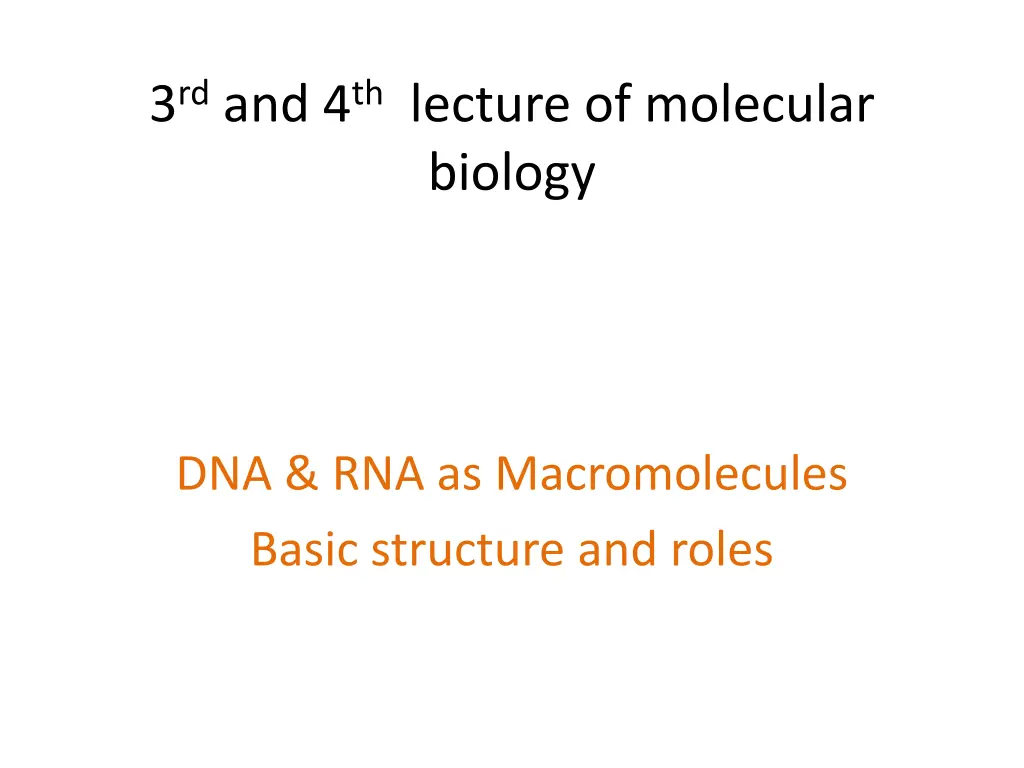
Understanding DNA and RNA Structures in Molecular Biology Lectures
Explore the basic structures and roles of DNA and RNA as macromolecules in molecular biology lectures. Learn about the essential components of nucleic acids, such as nucleotides, sugars, nitrogen bases, and phosphate groups. Understand the significance of DNA as the key molecule in cell function and reproduction, along with the interplay between nucleic acids and gene expression.
Download Presentation

Please find below an Image/Link to download the presentation.
The content on the website is provided AS IS for your information and personal use only. It may not be sold, licensed, or shared on other websites without obtaining consent from the author. If you encounter any issues during the download, it is possible that the publisher has removed the file from their server.
You are allowed to download the files provided on this website for personal or commercial use, subject to the condition that they are used lawfully. All files are the property of their respective owners.
The content on the website is provided AS IS for your information and personal use only. It may not be sold, licensed, or shared on other websites without obtaining consent from the author.
E N D
Presentation Transcript
3rdand 4thlecture of molecular biology DNA & RNA as Macromolecules Basic structure and roles
Type of Macromolecules Nucleic acid :including DNA {Deoxribonucleic acid} & &RNA { Ribonucleic acid}. Proteins Polysaccharid THE NUCLEIC ACIDS : DNA is the most importent molecule in living cells and contains all the information that the cell need to live and to propagate itself .with RNA they maintain the cell through Gene expression. Nearly all of the DNA present in eukaryotic cells can be found in the cell nucleus but it is present in cytoplasm in bacteria.
Basic structure of DNA A Nucleic Acid is a polymer consisting from nucleotides (the main structural units in nucleic acid) each nucleotide has the 3 following components: Cyclic five carbon sugar called ribose (in RNA) and as it devoid hydroxyl group attached to carbon no. 2 DNA structure thus it called deoxyribose, Nitrogen base the purine {adenine A and guanine G}and pyrimidine {cytosine C, thymine T and uracile U} .the first type consist from 2 rings while second type contain only one ring . A phosphate group (phosphoric acid) attached to the 5 carbon atom of the sugar by a phosphoester linkage .this phosphate group is responsible for the strong negative charge of nucleic acid
5 Nitrogen base :the blue nitrogen atom represent the place where the sugar attached to the nitrogen base
N base +sugar Nucleoside via N-glycosylic bond N base +sugar+ phosphate group Nucleotide
The bond between base and sugar is N- glycosylic bond the bond between sugar and phosphate is estar bond the bond between 2 bases is hydrogen bond
Carbon no:1 in Sugar attached to nitrogen NO. 9 in case of purine
Carbone no:1 in Sugar attached with nitrogen N0.1 in case of pyramidine
The attachment always occur from 3 end ,the bond between 2 adjacent nucleotide is called 3 5 phosphodiester bond
The primary structure of DNA represent one single strand ,not branched, result from binding polymer of nucleotides between the 3 OH free end of the upper sugar with the 5 P end (Pe phosphate) of the following nucleotide
The secondary structure of DNA represent by binding two single strand via hydrogen bond A=T and G C .the two strand are anti parallel to each (opposite direction )that is to say 3 end face the 5 end twisted together .
Nitrogen base in DNA : A T G C without U (Uracile only in RNA) .the back bone is the sugar- phosphate
Usually DNA is stored inside the cell as super helix rather than linear to reduce the it size thus DNA is longer than the cell itself
Other type of DNA rather than chromosomal DNA Plasmid DNA :It is a double stranded super helix DNA (extra chromosomal genetic material) usually found in bacterial cytoplasm .plasmid are not confined to bacteria but they have been isolated from yeast, protozoa and plants Mitochondrial DNA (mtDNA or mDNA) is the DNA located in organelles called mitochondria, structures within eukaryotic cells that convert chemical energy from food into a form that cells can use, adenosine triphosphate (ATP).In humans, mitochondrial DNA can be assessed as the smallest chromosome coding for only 37 genes and containing only about 16,600 base pairs. Human mitochondrial DNA was the first significant part of the human genome to be sequenced. Other type of DNA rather than chromosomal DNA Chloroplast DNA: present inside chloroplast responsible for its activity
The main difference between DNA and RNA is that the former is double strand while the latter is single strand and Thymine T is replaced by Uracile U
Watson and Crick used stick-and-ball models to test their ideas on the possible structure of DNA. They depend on structure conformation shape proposed Rosalind Franklin and Maurice Wilkins, who were using X-ray diffraction to understand the physical structure of the DNA molecule.
Basic 1-purines equal to pyrimidine bases within the anti parallel strand l 2-The DNA double helix is stabilized primarily by two forces: hydrogen bonds between nucleotides and stacking interactions among role in DNA double helix B form : base- aromatic nucleobases 3-It contain 2 groove, the major groove, is 22 wide and the other, the minor groove, 4-the backbone directed outside the helix while N.B oriented inside is 12 wide.
DNA display different shapes: During DNA preparation in lab and in electrophoreses processes this molecule may appear either 1- linear (L form )start with 5 end to 3 end .it could be turn to circular form by binding the two ends by ligase enzyme and losing H2O molecule .Also there is linear double stranded can convert to double closed circular relaxed form unwinding double helix 2- Open circular(OC) :when a nick occur in one of the double circular strands. it could be turn to closed circular 3- super coiled (also called CCC triple C) : The covalently (completely ) closed circular DNA usually exist in side the cell .run faster in gel electrophoreses ,
figure for electrophoresis's gel . The shiny bands is the DNA stained with ethidium bromid which is a chelating dye
Cleavage occur through endonuclease (enzymes break DNA) attack






















